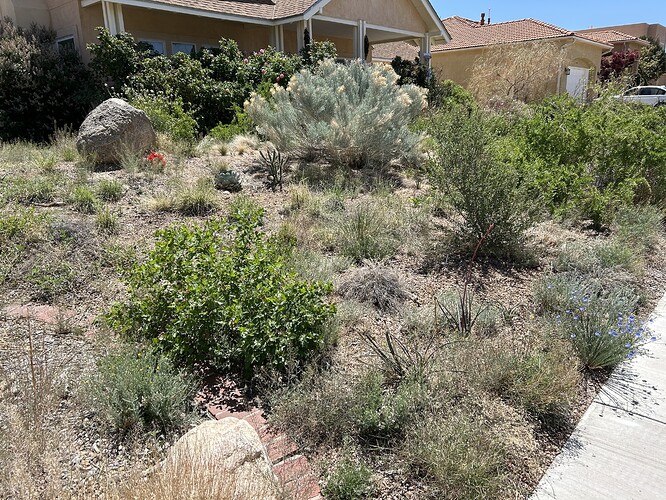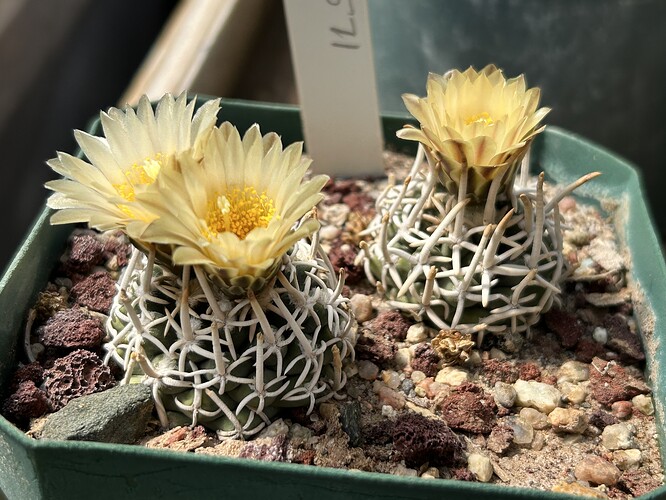It’s a little like trying to buy organic food–on a budget, it’s hard. Why not pick one perennial per year that is native (after you move) that you really like. Protect it as it grows and do the same each year, while using regular gardening plants for the rest (just make sure they aren’t incredibly invasive). If a native plant pops up in the garden protect it and keep an eye out in places where you can legally collect seeds. But, don’t over focus. Someday, if you have a bigger budget, then spend more, but for now, just do what you can. I, too, have little budget for natives and gardening is expensive in general. I hear your criticism. It’s valid. But, since nothing is going to change rapidly, do what you can do and give yourself credit for caring–it’s more than a lot of people do.
I think that’s what I need to do, personally. I’ve been driving myself a bit crazy lol “Doing the right thing” is really hard when it comes to gardening! For the most part, at least, my landlord, who is a landscape architect himself, is pleased with the work I’ve done. So there’s that!
I think a lot depends on where you are in the Pacific Northwest. I am near Portland, OR. It’s true that buying from native plant nurseries is different from buying from Home Depot or a general nursery. The market is smaller (sadly) because fewer people are doing it. I like Sauvie Island Natives, but they don’t do mail order. Sparrowhawk Natives is good but you can only get your plants twice a year - you send them the list and pick it all up at the same time. Once in the spring and once in the summer.
But the prices at Sauvie Island Natives are comparable to other nurseries. If you are paying more there, it’s because you only want larger plants.
Since it it is a rental that you will be moving out of soon and it sounds like your landlord has an interest in the yard being improved, is there any way you can get support from him in your endeavor? It seems to me that a landscape architect ought to have connections to nurseries and garden suppliers and might be able to get better rates. And if you are planting perennials that will add value to the property after you have left, I hope this is being taken into account in your rent.
He isn’t interested in spending any extra time or effort on what is, after all, just my hobby. He had enough on his hands with a much-needed bathroom renovation.
Creating an at-home project documenting species using your plantings might attract a future tenant willing to take over his rental and your online restoration project. That might get his attention. As an added bonus, you’d get to watch the new tenant make observations of species relying on your plants in your old project.
I forgot about that. Big box stores do carry some natives/nativars. Those are still better than non-native/invasive species. Someone else also mentioned the up front costs of annuals vs perennials, perennials cost more up front but will come back so cheaper in the long run, I agree with that.
If you have mammals that are bothering your plants if you have hot pepper powder and put it around the plants they will avoid it. This has worked for me when something keeps digging in my pots.
I’m unfamiliar with natives in the NW but there is a misconception that you can put a new plant in the ground, set it and forget it because its native. Sometimes you have to keep on eye on the plant the first season, water it until it gets established, goes for non natives too.
There is a lot of good info in the thread.
Edited for spelling.
This is so true - I was really peeved because my fiance said something like, “Native plants just take care of themselves!” as if I weren’t relentlessly toiling away in the garden and personally funding the native plant nursery.
Once the plants are established and larger I feel they do ok and can mostly fend for themselves. Last year I added a lot of new plantings in my yard. I had watered everything regularly to get the roots established. We had issues with drought last summer and I watered everything every morning. I still water on really hot days, but this year everything is a lot less maintenance.
Still troubleshooting the slug issue though. I have an established swamp milkweed, it sent up new shoots which got eaten. I might try diatomaceous earth or just move it to a pot until it grows enough and put it back. Apparently slugs will not cross a diatomaceous earth barrier, will have to try it.
Nvm, looks like diatomaceous earth is harmful to other bugs. Have to find some other way.
I agree - “going native” is an expensive, time-consuming, labor of love. I’ve been doing this in our front/backyards for the past 20 years. My wife and I have planted 1000’s of plants (we also manage a little piece of land in a nearby city park, for native plants).
We first had to remove so many non-natives, then spend time/money to amend the soils. Few if any urban soils (“urban” = developed) are hospitable to native plants. It’s a piece of work to prep the holes you’ve dug, which in my area, is like digging up concrete, ha ha.
My wife and I are fortunate to have enough income to have paid for so many plants, for the first 10 years. I also do plant swaps, have done rescue (no more, I’m too busy rescuing my own), grown from seed (dismal success rate), and people give me plants all the time (native ones mostly).
At least in my case, the plants need 2-4 years to become established. During that time, you have to baby them or else they perish. I’ve had many perish b/c many years ago I was traveling a lot for work (field work; avian ecology studies). I probably have a 75% success rate overall but after 1000+ plants, the cost in dollars is “material” (as my wife likes to say).
Every location has its “needs”. I learned to either plant early (early April) or wait till Oct/Nov. I use a baby pool to nurse my larger seedlings along until Fall planting. I use containers a lot to keep the rodents at bay, until the plants are old enough to “fend for themselves”.
I will say - in the past 5 or so years, I’d made enough contacts with other enthusiasts that now, all the new plants I get come free from my colleagues. But it took many years to get to this point…
I agree that turning over some soil just leads to more non-natives. That’s what happens here. We cannot remove say, a patch of English Ivy, unless I’m ready to replant almost immediately. Otherwise, the spot quickly fills up with Microstegium and other such pests. I do spot-treat areas with Glyphosate, on a “case by case” basis; mostly very small areas with a spray bottle. In spite of the ~20 years of pulling non-natives, we still spend a fair amount of time pulling non-natives… fortunately, my wife derives real satisfaction from pulling the 3-4 invasive ivy’s that keep showing up in our yards.
By the way, here’s what a low cost, mostly native, xeric, high desert landscape can look like. About 130 native-to-New Mexico plants are on my yard list, including some that died. The other big factor in cost of landscaping is aesthetics. I don’t care about mounds or crevices or raised beds or edging, but many people wouldn’t be happy with this level of chaos.
I don’t think it looks chaotic at all! beautiful. i’m big on edges but u have no idea how the Midwest has weeds. you wouldn’t even be able to see the house after year one. I try to use edged areas so I can work with the weeds since half of them are native weeds.
I adore a chaos yard but man people will get mad sometimes if you do it.
Still, i do my part and I’m at least trying to slowly increase the percentage of natives in my yars and get rid of invasives. I bought like five packs of spring beauty seeds from prairoe moon and i plan on just flinging them all over my yard. That should add to the chaos
Not true - I bought 5 seeds of California Dutchman’s Pipevine for $20 and not one came up.
Well, coffee is a good choice. Or, there’s my perennial favorite: cheap beer. (Not trying to promote anything, but after trying several brands, the “Blue Ribbon” American lager favored by hipsters and broke college students alike seems to be the most effective.) Or, if you want a more DIY solution, there’s a recipe at the end of this article. (Nota bene: I haven’t tried it, so I can’t say how it compares to the pre-canned version.)
I’m actually doing the beer traps right now which are very effective. I’ve used Yuengling and coors light, pretty much anything I can find around. I just feel kind of guilty about drowning them.
I was able to find a non lethal method for a while, putting decoy food like lettuce for them to eat instead of the seedlings which worked for a while. But they started getting out of control. It was war when they ate almost all the seedlings I had of a less common plant that I wanted to give to a conservation organization.
I’m almost done with seedlings, but I’m going to research the coffee grounds. We drink a lot of coffee here and if that can make a barrier that the slugs won’t cross I’ll try that next season. Hoping to find a non lethal method for next season since they have to eat too, but will probably do beer traps again if things get desperate.
It depends. Usually it is as simple as putting it in some soil and leaving it over winter and they sprout the following spring, but I’ve had some that failed.
I had a packet of Asclepias purpurea purple milkweed I purchased, not common here and those failed for whatever reason. Could be the age of the seeds, if they were gathered at maturity, or if they needed a certain type of stratification. Those seeds were expensive too. Most of the things in my jugs sprouted, but not all.
That is another thing too, a lot of natives can be weedy but there are some that are very fickle. I don’t know about the ones you tried growing, but there are a few natives that are picky IME. That purple milkweed is one of them, they might just have low germination rates.
Cactus in the Pediocactus and Sclerocactus genera are like this. They require freeze thaw or acid to crack the seed coat, then warm moist soil to germinate, but not too wet because they can die from mold or root rot. It’s all worth it for the flowers! Many desert plants are quite weedy in gardens, because lack of water limits their growth in the wild.
4 years in I’m still battling non native vetches, hedge parsley, bermuda, crepe myrtles…I feel like I’m beating my head against a wall.
17 years persistently pulling garlic mustard and honeysuckle. it’s something you have to look at as ongoing… and create a way to enjoy the process of ongoing removals.

